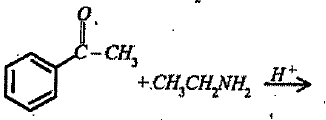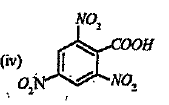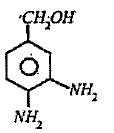Complete Solutions to QUESTION BANK of chapter ALDEHYDE, KETONES AND CARBOXYLIC ACIDS of Class 12 book with complete answers and questions
| Class 12 | CHEMISTRY |
| Chapter | ALDEHYDE, KETONES AND CARBOXYLIC ACIDS |
| A N EXCEL PUBLICATION | QUESTION BANK |
| Number Of Questions | 100 |
| Academic Year | 2023-24 |
Write the structures of the following compounds (i) `alpha`-Methoxypropionaldehyde
View SolutionWrite the structures of the following compounds (ii) 3-Hydroxybutanal
View SolutionWrite the structures of the following compounds (iii) 2-Hydroxycyclopentane carbaldehyde
View SolutionWrite the structures of the following compounds (iv) 4-Oxopentanal
View SolutionWrite the structures of the following compounds (v) Di-sec-butyl ketone
View SolutionWrite the structures of the following compounds (vi) 4-Fluoroacetophenone
View SolutionWrite the structues of the product of the following reactons. (i)

View SolutionWrite the structues of te product of the following reactons. (ii) `(C_6H_5CH_2)_2Cd+2Ch_3COCl gives
View SolutionWrite the structues of te product of the following reactons. (iii) `CH_3-C-=CH overset(Hg^(2+)H_2SO_4)rarr`
View SolutionArrange the following compounds in the increasing order of their boiling points. `CH_3CHO, CH_3CH_2OH, CH_3OCH_3, CH_3CH_2CH_3`
View SolutionArrange the following compounds in increasing order of their reactivity in nucleophilic addition reactions. (i) Ethanal, propanal, propanone, butanone
View SolutionArrange the following compounds in increasing order of their reactivity in nucleophilic addition reactions. (ii) Benzaldehyde, P-Tolualdehyde, P-Nitrobenzaldehyde Acetophenone
View SolutionPredict the products of the following reactions.

View SolutionPredict the products of the following reactions.

View SolutionPredict the products of the following reactions.

View SolutionPredict the products of the following reactions.

View SolutionGive the IUPAC names of the following. (i) `PhCH_2CH_2COOH`
View SolutionGive the IUPAC names of the following. (ii) `(CH_3)_2=CHCOOH`
View SolutionGive the IUPAC names of the following. (iii)

View SolutionGive the IUPAC names of the following. (iii)

View SolutionShow how each of the following compounds can be converted to benzoic acid. (i) Ethylbenzene
View SolutionShow how each of the following compounds can be converted to benzoic acid. (ii) Acetophenone
View SolutionShow how each of the following compounds can be converted to benzoic acid. (iii) Bromobenzene
View SolutionShow how each of the following compounds can be converted to benzoic acid. (iv) Phenylethene (styrene)
View SolutionWhich acid of each pair shown here would you expect to be stronger? (i) `CH_3COOH, FCH_2COOH`
View SolutionWhich acid of each pair shown here would you expect to be stronger? (ii) `FCH_2COOH, ClCH_2COOH`
View SolutionWhich acid of each pair shown here would you expect to be stronger? (iii) `FCH_2CH_2CH_2COOH` or `CH_3CHFCH_2COOH`
View SolutionWhich acid of each pair shown here would you expect to be stronger? (i) `CH_3COOH, FCH_2COOH`
View SolutionAldehydes and ketones are organic compounds containing carbonyl group. Write a chemical reaction to distinguish between aldehydes and ketones.
View SolutionAldehydes and ketones can be subjected to Clemmensen reduction and Wolf-Kishner reduction. Name the reagents used in both cases.
View SolutionHow will you make the following conversions? Ethanoic acid to ethanol.
View SolutionHow will you make the following conversions? Propanoic acid to 2-chloropropanoic acid.
View SolutionHow will you make the following conversions? Toluene to benzoic acid.
View SolutionFollowing are a group of compounds showing acidic behaviour:

Give the IUPAC names of these compounds.
View SolutionFollowing are a group of compounds showing acidic behaviour:does not contain carboxylic group, still it is acidic. Why?

View SolutionFollowing are a group of compounds showing acidic behaviour: Phenols are less acidic than carboxylic acids. Why?
View SolutionFollowing are a group of compounds showing acidic behaviour: Formic acid is stronger than acetic acid. Why?
View Solution
is an aromatic acid. What is it IUPAC name?
View SolutionExplain the conversion of the 3,4-dinitrobenzoic acid to the following.

View SolutionExplain the conversion of the above acid to the following.
`
View Solutionwrite the conversion of the 3,4-dinirtobenzoic acid to the following.

View SolutionAldehydes resemble ketones in many respects. Give the reason for their resemblance.
View SolutionAldehydes resemble ketones in many respects. Give a reaction in which aldehydes resemble ketones.
View SolutionWrite a test to distinguish between aldehydes and ketones.
View SolutionAldehydes resemble ketones in many respects. What is Cannizzaro reaction?
View SolutionWhich named reaction is used to reduce `CH_3COCl` to `CH_3CHO`?
View SolutionAldehydes and ketones undergo reactions due to the presence of `alpha`-hydrogen atom. Write the name of the reaction of aldehyde which takes place only because of the presence of `alpha`-hydrogen atom.
View SolutionHow will you bring about the above reaction?
View Solution`CH_2ClCOOH` is a stronger acid than `CH_3COOH`. Why?
View SolutionHow will you convert `CH_3COOH` to `CH_2ClCOOH`?
View SolutionComplete the following. Write down the structures of A, B and C. (i) `CH_3-CH_2-CHO overset(KMnO_4)rarrA`
View SolutionComplete the following. Write down the structure of B. (i) `CH_3-CH_2-CO-CH_3 overset(Zinc amalgam//HCl)rarrB`
View SolutionComplete the following. Write down the structure of C. (i) `CH_3-CH_2-CH_2-COOH overset(Bromine//Red P)rarrC`
View SolutionWrite down the IUPAC names of A, B and C.
View SolutionExplain the following reactions. Cannizzaro reaction
View SolutionExplain the following :
Esterification
View SolutionSuggest a method of preparation of benzaldehyde from toluene.
View SolutionAldehydes and ketones differ in their chemical reactions. How do they with the following.? Tollens's reagent
View SolutionAldehydes and ketones differ in their chemical reactions. How do they with the following.? Alcohol
View SolutionHow will you convert propanoic acid into the following componds? Ethane
View SolutionHow will you convert propanoic acid into the following compond? Butane
View SolutionAmong formaldehyde, acetaldehyde, benzaldehyde and formic acid, which compounds undergo Cannzzaro reaction? Give reason.
View SolutionExplain the following :
Esterification
View SolutionThionyl chloride is preferred to as the reagent to prepare acid chlorides. Why?
View SolutionWrite the chemical reaction to effect the transformation of sodium acetate to ethane.
View SolutionWhich is not the isomer of `CH_3-CH_2-O-CH_2-CH_3` ?
a)`CH_3-O-CH_2-CH_2-CH_3`
b)`CH_3-CH_2-CH_2-CH_2-OH`
c)`CH_3-CH_2-CO-CH_3`
d)`CH_3-CH(OH)-CH_2-CH_3`
View SolutionWrite the IUPAC names of the `HOOC-CH_2_COOH` compound.
View SolutionAldol condensation reaction is a special reaction of aldehydes. (i) What is aldol condensation reactions?
View SolutionAldol condensation reaction is a special reaction of aldehydes. (ii) Write the structural formula of aldol formed from ethanal.
View SolutionWrite simple chemical tests and observations used to distinguish between the following compounds. (i) Propanal and propanone
View SolutionWrite simple chemical tests and observations used to distinguish between the following compounds. (ii) Phenol and benzoic acid
View SolutionWrite the names of reagents used to bring about the following transformations. (i) `C_6H_5COCl rarr C_6H_5CHO`
View SolutionWrite the names of reagents used to bring about the following transformations. (ii) `CH_3COOH rarr CICH_2-COOH`
View SolutionMethanal (HCHO) is an aldehyde having no `alpha` hydrogen atom. What are the products formed when methanal is treated with strong KOH solution?
View SolutionHow are the following conversions archieved? (i) Benzoyl chloride `[C_6H_5COCl]` to benzaldehyde `(C_6H_5-CHO)`
View SolutionHow are the following conversions archieved? (ii) Acetic acid `(CH_3COOH)` to chloro acetic acid `(CH_2Cl-COOH)`
View SolutionHow are the following conversions archieved? (iii) Benzene to Benzaldehyde
View SolutionAldehydes, Ketones and Acids contain `>>C=O` group. Name the product obtained by the reaction between Acetic acid and Ethanol.
View SolutionWrite a test to distinguish between aldehydes and ketones.
View SolutionTwo chemical reactions are given below: (1) Identify the products of each reaction.

View SolutionTwo chemical reactions are given below: (2) Give the name of each reaction.

View SolutionExplain aldol condensation taking `CH_3-CHO` as example.
View SolutionWrite the named reactions involved in the following conversions: (i) `CH_3-CO_Cl overset(H_2//Pd-BaSO_4)rarrCH_3-CHO`
View SolutionWrite the named reactions involved in the following conversions: (ii) `2HCHOoverset(NaOH)rarrHCOONa+CH_3-OH`
View SolutionHow are the following conversions achieved? (i) `CH_3-CN rarr CH_3-COOH`
View SolutionHow are the following conversions achieved? (ii)
` (##ANE_PKE_CHE_XII_C12_E02_058_Q01.png" width="80%">
View SolutionAldehydes, Ketones and Carboxylic acids are Carbonyl compounds. Aldehydes differ from Ketones in their oxidation reaction. Illustrate with one example.
View SolutionHow will you prepare benzaldehyde by Gatterman-Koch reaction?
View SolutionWrite the reactions of carboxylic acid with the following reagents. (Write the chemical equations) (i) Thionyl chlorides `(SOCl_2)
View SolutionWrite the names of reagents used to bring about the following transformations. (ii) `CH_3COOH rarr CICH_2-COOH`
View SolutionWrite the reactions of carboxylic acid with the following reagents. (Write the chemical equations) (iii) Lithium Aluminium hydride `(LiAlH_4)` ether.
View SolutionWrite a test to distinguish between aldehydes and ketones.
View SolutionHow will you prepare benzaldehyde by Etard's reaction?
View SolutionHow will you bring about the following conversions? (Write the chemical equations) (i) Ethonal to ethene
View SolutionHow will you bring about the following conversions? (Write the chemical equations) (ii) Benzamide
View SolutionHow will you bring about the following conversions? (Write the chemical equations) (iii) benzoic acid to Benzaldehyde
View SolutionAldehydes, Ketones are the compounds having >C=O group. Choose the IUPAC name of the compound `CH_3CH=CH=CHO`
View SolutionComplete the reaction: `2HCHO+Con KOHoverset(Delta)rarr`
View SolutionComplete the reaction: `CH_3CHOoverset(dil.NaOH)rarr`
View SolutionComplete the reaction: `CH_3CHO+H_2N-NH_2rarr`
View Solution
QUESTION BANK questions and complete solutions for chapter ALDEHYDE, KETONES AND CARBOXYLIC ACIDS of A N EXCEL PUBLICATION of Class 12